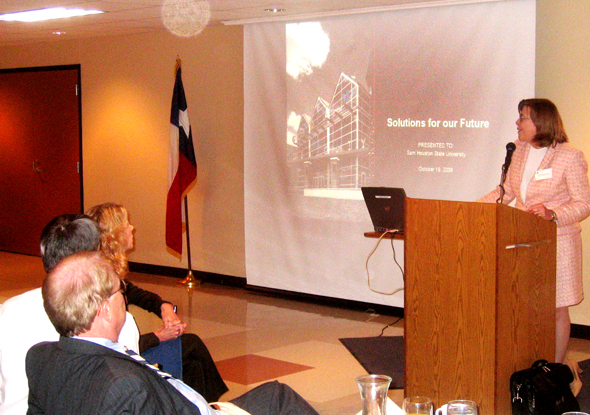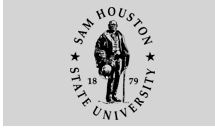SHSU Group Hears Details of National Education Campaign
 |
| Maureen Berry gives details of the Solutions for Our Future
campaign to encourage support for education. |
If you know
where to look, you can find some funny public service
announcement TV spots that promote higher education. Much like
higher education, they have received relatively little attention.
The ads are
part of Solutions for Our Future, a national campaign by the
American Council on Education to encourage U. S. citizens to
look beneath the surface of higher education--to consider the
role colleges and universities play in serving the public, solving
pressing societal needs, and preparing people for the country's
future.
Maureen Berry
of the Austin advertising firm of GSD&M, one of the partners
in the project, spoke about it to 85 Sam Houston State University
administrators who gathered for the President's Breakfast Series
presentation Thursday morning in the Lowman Student Center.
"We (education) really
are the last noble cause," said Berry.
The campaign's
objective, she said, is general public support and government
funding for higher education. William Kirwan, chancellor of the
University System of Maryland, summarized the need for such a
campaign.
"We are
in the early stages of a major crisis in our country," said
Kirwan on the campaign Web site. "We are basically building
an education deficit."
Berry said
that research done to prepare for the campaign showed that people
do not identify higher education as among the country's most
pressing issues, such as the war in Iraq, crime, or the economy.
Also, they don't see a broad-based benefit to higher education,
and don't believe it's a basic necessity.
"We want
to show what higher education can do for the country," said
Berry, "not just its personal benefits. People don't realize
how many truly practical solutions come from higher education."
One of the TV ads, for instance, shows a delivery company employee
attaching a pigeon to a large package, and ordering it to take
it by "air
mail" to Sacramento. Overnight delivery and the Google search
engine are just two "solutions" that came from higher
education, it reminds.
Another shows
a man whose hand is caught in a pickle jar. A doctor recommends
he and a patient with a broken leg be treated by bloodletting.
It makes the point that open-heart surgery and other medical
advancements came from colleges and universities.
The third shows
a person calling 911 because she fears a break-in. The dispatcher
advises she get a "rolling pin or a golf club," because
the local community college is short of funds. Eighty-three percent
of police and fire first responders are trained in community
colleges.
A future ad will show a sports fan holding a large hand with
the index finger extended in the traditional "We're Number
1" position. The only problem is that on the hand is written "We're
Number 9." Among nations, the United States is 9th in the
number of students in higher education.
Berry said that the TV ads were distributed nationally but
not used extensively. They were run by the NCAA during last spring's
basketball playoffs and on the Fox network. The Wall Street Journal
also donated five full page ads.
All of the spots
are available for viewing online.
The campaign's home Web site is solutionsforourfuture.org.
Other points
made by the campaign, which are detailed on its Web site, include:
College graduates
volunteer more, vote more often, and participate more in community
and civic organizations;
Students learn
to think critically and solve the problems facing our country;
A college
degree increases earnings, but everyone benefits because education
increases tax revenues, lowers demands on social support programs,
and increases productivity.
James F. Gaertner,
SHSU president, hosted the breakfast and introduced Berry.
"We have
a noble cause," he said, "and it's so easy to forget
that when we're immersed in our day-to-day activities."
—END—
SHSU Media Contact: Frank Krystyniak
Oct. 19, 2006
Please send comments, corrections, news tips to Today@Sam.edu.
|


